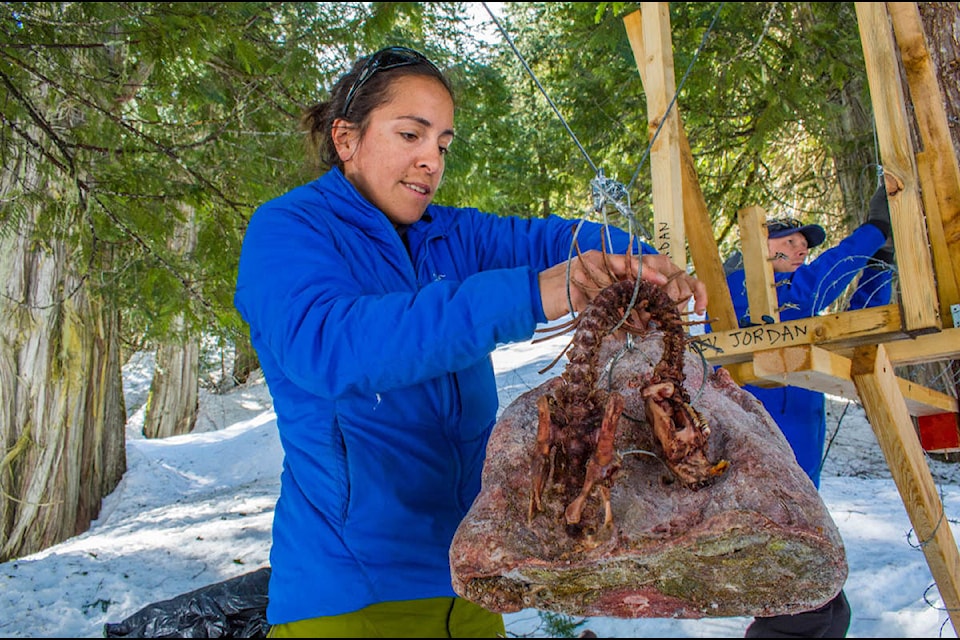In a clump of trees, Mirjam Barrueto removes three wolverine hairs with tweezers from barb wire. The remains of a beaver dances in the breeze above, attached to a nearby tree by a long looping wire. The wolverine wasn’t quite able to finish its meal.
“This animal is really close to my heart,” says Barrueto. She puts the hairs into a small envelope, making note of how many it contains. Only three hairs are needed for genetic work.
Barrueto has studied wolverines, the largest non-aquatic member of the weasel family in North America, for seven years.
She’s part of a study led by the University of Calgary that is looking at wolverines throughout the Columbia and Rocky Mountains, roughly 50,000 square km in total area.
The project uses remote cameras and hair snagging to examine the effects of human activities, such as logging and snowmobiling on breeding female wolverines. Today, Barrueto is visiting sites in the Revelstoke area.
READ MORE: Where are the wolverines? Researchers need your help
READ MORE: From wolverines to whitebark pine – An interview with Parks Canada’s Sarah Boyle
Wolverines are tempted to sample sites with dead beavers and lure made from skunks. Hairs are snagged on barb wire, clamps, and sent for analysis.
“Wolverines love this kind of stuff,” says Barrueto as she wraps a parcel of cloth drenched in skunk scents and hangs it from a nearby tree. The air is thick with interwoven scents.
Wolverines are listed as a species of special concern under the Canadian Species at Risk Act and endangered in the U.S. They are one of the least studied mammals in North America. Their home ranges are the most rugged and remote regions of Canada, stretching across areas of Quebec, Ontario, Manitoba, Saskatchewan, Alberta, B.C. and the territories. It’s unknown how many are left.
Barrueto has 153 study sites, many of which are only accessible by helicopter. She hopes to track wolverines by DNA sampling and unique white markings on their chests, captured by wildlife cameras as they feast on beavers.
| Barrueto's project attempts to track wolverines by their unique white chest markings (Submitted) |
“To follow them is incredibly hard, to study them is very challenging and expensive. It takes a lot of determination to do any wolverine studies,” says Barrueto.
In 2012, a study suggested there are less wolverines in the Kootenays than previously thought, to such an extent that the animal may be over harvested. Barrueto says it’s important to study wolverines because there are so many things happening on the landscape. Researchers need to gather more data to make proper policies for a species potentially facing risks.
“Wolverines are rare, but they don’t have to become endangered.”
Since the mid-1960s, B.C. has been the top producer of wolverine pelts. In 2009, more than 500 pelts were harvested in Canada. Wolverine fur is resistant to the build-up of frost and has long been used as trim on parkas.
The animal can be very sensitive to human disturbances and in some cases, says Barrueto, will not even cross highways, which is important for land managers to note because if all the wolverines are harvested on one side of a highway, that population may not be replenished.
“A species that doesn’t reproduce very fast, that’s pretty rare naturally, that’s not resilient against human impacts, is a species we have to take care of if we want them on the landscape.”
The study would like the public to report wolverine sightings at wolverinewatch.org
Barrueto says this is one of the first times so many different organizations and companies have come together to study wildlife. The main supporters in the project are the University of Calgary, Parks Canada, BC Parks, Y2Y Initiative, Helicat Canada, Mike Wiegele Heliskiing, K3 Cat Skiing, Selkirk Tangiers Heli Skiing, Mustang Powder, Habitat Conservation Trust Foundation, FESBC, CMH and Whitetooth Helicopters.
The study is having a large fundraising drive starting April 1. Funds donated will be matched by the University of Calgary. Donations can be made a wolverinewatch.org/supportus.
After Barrueto sets the lure, she trudges back to the waiting helicopter. A lone bird chatters, a nearby creek gurgles and giant cedars groan in the wind. As the helicopter flies back to base, somewhere below, a wolverine searches for its next meal.
